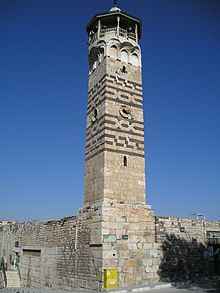| Nur Al-Din Mosque جَامِعُ نُورِ الدِّينِ | |
|---|---|
 The minaret of Nur al-Din Mosque | |
| Religion | |
| Affiliation | Islam |
| Region | Levant |
| Status | Active |
| Location | |
| Location | Hama, Syria |
| Geographic coordinates | 35°8′6″N 36°45′9″E / 35.13500°N 36.75250°E |
| Architecture | |
| Type | Mosque |
| Style | Zengid |
| Completed | 1172 |
| Specifications | |
| Minaret(s) | 1 |
| Materials | Basalt, Limestone, Tiles |
The Nur Al-Din Mosque (Arabic: جَامِع نُور ٱلدِّين, romanized: Jāmiʿ Nūr ad-Dīn, transliteration: Jami Nur al-Din) is a Zengid-era mosque in Hama, Syria.[1] It was founded by Nur al-Din in 1163-64 CE. It also contained a historic minbar from the same date, which is now held at the local Hama Museum.[2]
The mosque was profoundly damaged in the 1982 shelling of the city and subsequently restored to its current state.
References[edit]
- ^ Nur al-Din Mosque Archnet Digital Library.
- ^ Hafian, Waal. "Minbar". Discover Islamic Art, Museum With No Frontiers. Retrieved October 18, 2020.
Bibliography[edit]
- Rihawi, Abdul Qader (1979). Arabic Islamic Architecture: Its Characteristics and Traces in Syria. Publications of the Ministry of Culture and National Leadership.






Well, that’s interesting to know that Psilotum nudum are known as whisk ferns. Psilotum nudum is the commoner species of the two. While the P. flaccidum is a rare species and is found in the tropical islands. Both the species are usually epiphytic in habit and grow upon tree ferns. These species may also be terrestrial and grow in humus or in the crevices of the rocks.
View the detailed Guide of Psilotum nudum: Detailed Study Of Psilotum Nudum (Whisk Fern), Classification, Anatomy, Reproduction